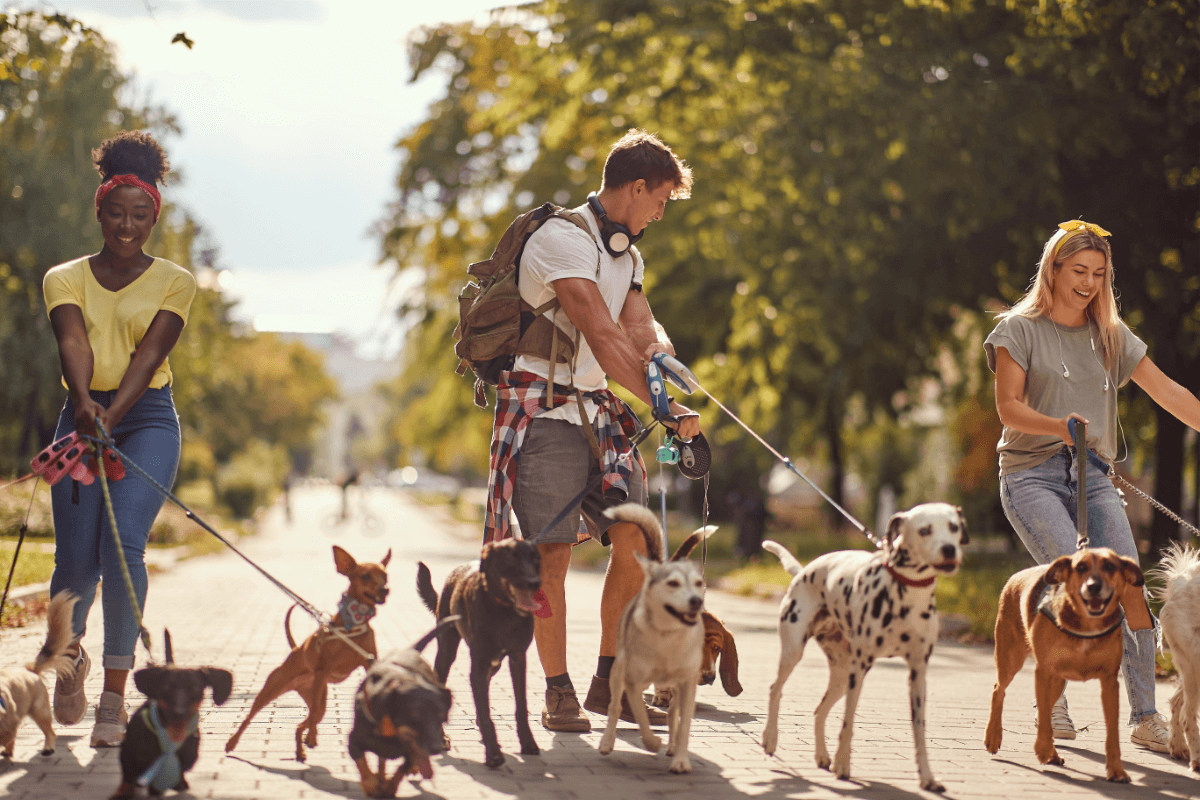
Where can you find impressive trails and safe conditions for dog walking?
To mark National Walk Your Dog Day on Feb. 22, LawnStarter ranked 2024’s Best Cities to Walk Your Dog.
We compared nearly 480 of the biggest U.S. cities based on 4 categories. We looked at access to dog-friendly trails and off-leash parks with paw-sitive ratings, dog walking services, and safety, among 17 total metrics.
Leash up and rove through our ranking below. To learn how we ranked the cities, see our methodology.
Contents
- Rankings
- Top 5 Close Up
- The Upshot
- Talking the Talk: Expert Insights
- Behind the Ranking
- Walking the Walk: Healthy and Happy Hounds
Rankings
See how each city fared in our ranking:
Top 5 Close Up
Check out the slideshow below for highlights on each of our top 5 cities.
The Upshot
Western cities trotted to the top of our ranking, thanks to their vetted pup-friendly trails. Cities like Colorado Springs, Colorado (No. 1), San Francisco (No. 2), and Phoenix (No. 3) offer plentiful paths for taking Buddy on a stroll.
Texas suburbs — Flower Mound (No. 13), Georgetown (No. 16), and Mansfield (No. 19) — outwagged their bustling neighbors Austin (No. 21), Dallas (No. 126), and Fort Worth (No. 172) despite having fewer dog parks and trails. These suburbs bark up safer walking conditions for pedestrians and their pooches in addition to better-rated routes.
You might have a ruff time walking the dogs in Kansas City, Kansas (No. 469), Montgomery, Alabama (No. 470), and Memphis, Tennessee (No. 475), though. These cities heeled at the tail end of our ranking with poorly rated trails and high rates of pedestrian fatalities.
Unleash more interesting insights below.
Talking the Talk: Expert Insights
Unless you’re celebrity dog whisperer Cesar Millan or a very experienced dog owner, you might not be aware of the right and wrong ways to walk your furry friend.
To help maximize fun time and safety, we turned to a pack of canine experts for tips and insights. See what they had to say below.
- What are the three biggest benefits of walking one’s dog for pet parent and pup?
- What are the top three most common mistakes pet parents make when walking their dogs, and how can those mistakes be avoided?
- What are the three best ways to ensure safety during a walk with one’s dog?
- What is your No. 1 tip for making dog walking the best possible experience for both pup and owner?








What are the biggest benefits of walking one’s dog for both pets and people?
People and pets need mental and physical exercise. For dogs, walking is an important part of a daily routine and helps to keep them fit and provides them with opportunities to explore their environment, use their senses, and get the mental and physical stimulation they need. Walking can also help to prevent boredom, which can lead to destructive behaviors in dogs.
Surveys have shown that over 50% of pet dogs are overweight and anywhere from 45-85% (depending on the study) have a reported behavior problem. Not all behavior problems are going to be cured by exercise, but part of behavior modification includes adequate exercise which will make a behavior problem easier to manage. Walking is one way to allow a dog to use their senses and body to become physically and mentally tired.
Consciously allowing portions of the walk to be “sniffing” will provide mental stimulation while spending the rest of the walk walking briskly allows the human and pet to work their muscles.
For people, walking a dog is a great form of exercise that can improve cardiovascular health, strengthen bones, decrease blood sugar levels, and improve mental well-being. It can also be a social activity, as it provides an opportunity to meet and interact with other people and dogs.
What are the top three most common mistakes people make when walking their dogs, and how can those be avoided?
- Not paying attention to their dog: It is important to pay attention to your dog while you are out for a walk, as this will help you to notice any changes in their behavior or body language that may indicate that they are distressed or uncomfortable. If you are not paying attention to your dog, you may miss these cues, which can lead to problems.If you have an older dog, it is important to watch for these cues. Older dogs may have joint disease. While we want them to stay active to maintain good muscle tone and receive that mental stimulation, we must watch their body language to gauge their fitness and increase duration incrementally.
- Not training your dog to walk on a leash and not using a leash: It is important to use a leash, especially if you are in a public place or an area where there are other people or animals present. Not using a leash can lead to your dog getting loose and possibly getting injured or causing harm to others.A dog that constantly pulls on a leash can be frustrating and unsafe for the human. It is important to teach your dog how to walk on a leash properly. This includes teaching them to stay by your side and not pull on the leash. This is easier said than done with some dogs and you shouldn’t be ashamed to seek help from a trainer.
- Not building your dog’s fitness gradually: If your dog isn’t accustomed to exercise, you may need to build fitness over time, especially if they are overweight or older. Walking is a safe activity for dogs as it is low impact without sudden stops or turns at speed. Taking easy or moderate walks regularly is better than a “big adventure” that becomes too strenuous for pets and people and can cause injuries.
What are the three best ways to ensure safety during a walk with one’s dog?
- Use a leash: As mentioned earlier, using a leash is important for keeping your dog safe and preventing them from getting loose and potentially getting injured or causing harm to others. Make sure to use a leash that is appropriate for your dog’s size and strength.
- Stay aware of your surroundings: It is important to be aware of your surroundings while walking your dog, as this will help you notice any potential hazards or dangers, such as traffic, other animals, or items your dog may pick up off the ground.Make sure to keep your dog away from any potentially dangerous situations and stay alert for any changes in your environment. Being aware of your surroundings allows you to create some distance between your dog and the potential hazard before it becomes too exciting. Choose a route that minimizes hazards and annoyances.
- Keep your dog up to date on vaccinations and preventive care: Ensuring that your dog is up to date on their vaccinations and preventive care is important for their overall health and well-being, as well as for the safety of others. This includes keeping your dog on a monthly flea, tick, and heartworm prevention regimen, as well as getting them vaccinated against diseases such as rabies, distemper, and parvovirus.
What is your top tip for making walks with your dog the best possible experience?
Focus on building a strong bond with your dog. This can be achieved through consistent training and positive reinforcement, as well as by spending quality time with your dog and providing them with plenty of love and attention.
Dress appropriately –– dogs and humans alike! Not all dogs love cold or wet weather. Some dogs enjoy protective clothing like raincoats or warm sweaters. On the other hand, your long-haired fluffy dog will be unfazed and likely will not enjoy or need clothing.
Finally, be sure to bring along plenty of water and any other necessary supplies, such as waste bags and treats, to make your walk as enjoyable and comfortable as possible for you and your dog.

What are the three biggest benefits of walking one’s dog for pet parents and pups?
- The benefit to both pets and parents is the exercise. Stay active. Just like their owners, pets can begin to struggle with weight and arthritis as they age. Walking these “kids” helps keep the owner and the pet in shape.
- Socialization is also healthy for both pets and owners. I can’t tell you how many friends I’ve made in my neighborhood or at parks while walking my boys. It’s a wonderful way to meet new people. Dogs need socialization to help avoid unwanted behaviors, such as fear and aggression.
- Certain breeds have copious amounts of energy and need something to do with that energy. If they are kept indoors for too long, they can begin to exhibit destructive behaviors or anxiety.
- I’m adding a fourth benefit because it must be included, and that’s the bond that forms between the animal and human. This helps build trust and strengthens bonds between owners and their pets.
What are the top three most common mistakes pet parents make when walking their dogs, and how can those mistakes be avoided?
- Letting dogs off-leash. With the exception of dog parks, dogs should be kept on leash to avoid running out into the streets and potentially getting hit by a car. This also avoids potential scraps with other dogs. Not all dogs want to meet your pet. They’re more comfortable observing from a distance. No matter how well-trained your dog may be, being off-leash can make others uncomfortable.
- Allowing puppies to socialize when they aren’t fully vaccinated. I see this all the time. Puppies are fun and are ready to play with any other animal or human they see. However, without proper vaccines, they are at risk of catching various diseases from other dogs. Puppies should not be taken to dog parks until fully vaccinated.
- When hiking with pets, it’s not uncommon for owners to allow their dogs to take off and run around –– let them be free. While some hiking areas allow this, keep in mind that the wildlife in the area carries various parasites, or they may be lurking in the brush nearby. Areas with high occurrence of rattlesnakes should have dogs kept on leash to avoid encounters.
What are the three best ways to ensure safety during a walk with one’s dog?
- As stated earlier, keep the dogs on a leash. If considering taking your dog to a dog park, make sure your dog isn’t aggressive and will not be likely to attack others.
- I find that harnesses and gentle leaders tend to work best for dogs. The old school of thought of using a choke collar or pinch collar has been deemed archaic by some. Larger, more muscular breeds will still drag their owners around even while wearing a choker or pinch collar. The owner becomes more frustrated with the dog who won’t calm down and then are more likely to cause the dog physical harm in their frustration.Gentle leaders which have the collar around the dog’s neck and muzzle allow the owner more control, and the dog is much less likely to cause frustration. Harnesses have been a popular choice with your brachycephalic (flat-faced) breeds as they won’t collapse the throat if they pull. They already struggle to breathe; let’s not make it worse.Side notes about shock collars –– these collars have been known to activate because of the frequency of a plane or garage door. This leads to severe burns on occasion. Personally, I’m not a fan of those collars for that reason. I believe positive reinforcement is best and can be done correctly using a gentle leader and treats.
- Do not walk your dogs if the pavement is too hot. We see constant pad injuries due to burns from hot pavement. Likewise, if after a snowstorm, don’t walk your pet on the icy roads. These roads are obviously cold, but also usually have chemical treatment on them. These can cause chemical burns to the pads. Snow boots for pets can help to avoid this and make for a much safer walk.
What is your No. 1 tip for making dog walking the best possible experience for both pup and owner?
I always carry a small baggie of bite-sized treats. I can reward my boys when they behave well in certain social settings. I can also give them to other dogs who we encounter to promote positive reinforcement. This, of course, is assuming the other owner is okay with their dog receiving the treat, as some dogs have allergies.
If the walks are long, I carry a small container for water since these kids can work up a sweat. In hotter conditions, heat stroke is always a concern so be mindful of weather conditions and choose a time of day that would be safer for both you and your pet.

What are the three biggest benefits of walking one’s dog for pet parents and pups?
- Pet parents are more likely to engage in physical activity, such as walking, than non-pet owners. This is associated with a lower risk of obesity and improved cardiovascular health. The American Heart Association has even provided a Scientific Statement that describes how pet ownership is associated with the prevention of cardiovascular disease. The physical activity of walking a dog is a key component of this lowered cardiovascular risk.
- Walking is also important for your dog’s health. We know that pet obesity is increasing within the United States and that dogs with a healthy body condition (e.g. not overweight) live longer than overweight dogs. Aside from managing a dog’s nutrition, walking provides important physical activity to keep them healthy.
- The human-animal bond, something that supports the physical and mental health of people and their pets, is strengthened and supported by our interaction with our pets. Spending this active time with our dogs is mutually beneficial for dogs and their families. People and animals are found to have fewer stress hormones and more positive, connection-related hormones when they engage in these activities together (as compared to people or animals that do not).
What are the top three most common mistakes pet parents make when walking their dogs, and how can those mistakes be avoided?
- Not having an adequate leash or ability to manage your dog while meeting other people or dogs. Not all dogs will get along with other dogs and people. Avoid retractable leashes, train your dog to leash walk and respond to your verbal instructions, and always ask other people if it is ok for your dog to meet other dogs and people before allowing the dog to approach. Consider looking into Canine Good Citizen training as described through the AKC.
- Not appropriately socializing a puppy. Socialize your puppy appropriately and early to ensure a lifetime of comfortable interactions with other people, animals, and experiences. Puppy socialization needs to occur during a narrow critical period early in life, specifically between 3-14 weeks of age. Socializing your dog appropriately will make walking less stressful and more enjoyable for the pups and their families. Lack of socialization can lead to stress for your pup and perceived behavioral problems (e.g. aggression, submissiveness, fear).https://www.avma.org/resources-tools/animal-health-and-welfare/socialization-dogs-and-cats
- Not cleaning up after your pup. It’s not the most glamorous part of being a pet family, but picking up your pet’s waste is important for animal and human health. Parasites can be spread to other dogs and people through the waste.
What are the three best ways to ensure safety during a walk with one’s dog?
- Outfit your pup with an appropriate leash and collar. Avoid retractable leashes that give a false sense of security and keep your dog within 6 feet of you. Certain metal collars can pinch and cause skin problems, so if your dog is pulling, look into other harnesses or leads that help prevent pulling, and train your dog appropriately to use them while walking.
- Always communicate with other people before assuming it is okay for your dogs to interact. Ask how their dog is with other dogs and make sure both dogs are on a leash. There is a power disparity if one dog is on a leash and the other is not.
- Carefully watch the ground where your dog is walking for food or other trash that your dog may wish to eat. Dogs can ingest food, toxins, or physical objects that will make them sick. I have known more than one dog that had to walk wearing a basket muzzle to prevent them from constantly eating things outside and becoming sick.
What is your No. 1 tip for making dog walking the best possible experience for both pup and owner?
Be present and enjoy the time you have together. It’s easy for us to be busy and feel like these activities are a chore. When you get your pup out for a walk, try practicing some mindfulness to slow the world down and savor the moment. Observe the colors and objects around you, consider the temperature of the air and how it feels, and relish your pup’s enjoyment of the walk.

What are the three biggest benefits of walking one’s dog for pet parents and pups?
- For pet parents, it gives them a chance to exercise and relax.
- For dogs, it also gives them a chance to exercise.
- It also gives pets the opportunity for enrichment by exploring the environment and possibly interacting with other dogs. Make sure your dogs are fully vaccinated if that occurs, but more on that later.
What are the top three most common mistakes pet parents make when walking their dogs, and how can those mistakes be avoided?
- Be careful that your dog does not get overheated. If it’s a hot day, and especially if the dog is overweight or has a heavy coat, the dog may not be able to shed heat the way people can and may get heat exhaustion.
- Be careful not to go too fast for your dog. I see many pet parents who are “walking” their dogs while the pet parents are on a bicycle. The dog may not be able to comfortably keep up. Even if you run with your dog, make sure you know the dog’s abilities.For example, a Chihuahua has much shorter legs than the person, so while the pet parent thinks that they’re just out for an easy jog, the dog may be running at full speed. Also, the dog needs to sniff and explore its environment, so be sensitive to the dog’s needs and give it time to explore. Remember that the dog’s walk is part of its environmental enrichment.
- Use a harness instead of a collar. Tugging on the dog’s neck can cause problems, especially if it’s a dog that’s prone to respiratory issues, such as many brachycephalic (flat-faced) breeds. Those breeds already have morphological anomalies regarding their upper respiratory airways, so tugging on a collar is not good –– a body harness is much better.
What are the three best ways to ensure safety during a walk with one’s dog?
- Stay on the sidewalk and off streets or busy bike paths.
- If you are using a retractable leash, limit the length so that the dog cannot run into the street into the path of a car.
- Have your dog vaccinated for the following: rabies, canine distemper, canine parvovirus, canine adenovirus, bordetella, and parainfluenza (two components of “kennel cough”). This is especially important if your dog encounters other dogs –– even “friendly” encounters.It’s also important if you take your dog to a dog park. Remember that not all interactions between dogs end well. If your dog bites a person or another dog, you definitely want to ensure your dog is vaccinated for rabies. You may think that your dog is not aggressive and won’t bite –– and that may be true; however, if the other dog starts a fight and a human tries to break it up and ends up getting in the way of your dog’s defensive snaps, it is still considered a bite.
What is your No. 1 tip for making dog walking the best possible experience for both pup and owner?
Put yourself in the dog’s place and try to be conscious of what the dog may experience during the walk. Also, think about what you’d like the dog to experience. This essentially encapsulates all the above pointers in a nutshell since it involves the consideration of the enrichment and potential health and safety hazards.

What are the three biggest benefits of walking one’s dog for pet parents and pups?
- Building and maintaining a positive social relationship
- Physical exercise
- Allowing a dog to exercise their senses –– their ever-working nose, ears, and eyes, and having fun. The walks should be for the dogs and shouldn’t be rushed or cut short. You wouldn’t want to be yanked, scolded, or told “there’s nothing there” if you are sniffing, searching for a sound, or trying to see what’s happening around you.
What are the top three most common mistakes pet parents make when walking their dogs, and how can those mistakes be avoided?
- They hurry the dog along and don’t allow them to exercise their noses, ears, and eyes.
- They yank the dog by a lead and scold the dog for being too slow or disobedient.
- They force the dog to walk faster than the dog wants to, as the dog takes what’s happening in their surroundings, familiar or not. Just because a dog has been somewhere countless times, there are still always new things for them to explore and process.
What are the three best ways to ensure safety during a walk with one’s dog?
- Don’t yank a dog here and there because it can injure them.
- If they’re lagging make sure they’re feeling okay. Just because they’re out on a walk that should be fun doesn’t always mean they’re enjoying themselves –– they may be ill, injured, or simply having a bad day.
- Be sure that when they meet another dog, they really want to say ‘hello’ and sniff them. Pay attention to the dog’s personality –– sometimes they want to say ‘hello’ and sometimes they just want to be left alone.
What is your No. 1 tip for making dog walking the best possible experience for both pup and owner?
Be sure you and your dog are on the same page regarding what is happening and yield to what they want –– their walk is for them, not you, so honor what they want, and if it’s not what you want, that’s too bad.

What are the three biggest benefits of walking one’s dog for pet parents and pups?
- The benefits of physical activity for both the dog and its parents are huge. We know that walking outside daily helps physical and mental health for people, and the same goes for dogs. Imagine if you were cooped up in the house all day, every day, for most of your life. That would get boring pretty quickly. At SUNY Canton, all our dogs housed at the Newell Veterinary Technology Center are walked four times daily. We see benefits for the animals and students alike.
- Walking is mentally and physically stimulating for dogs. Dogs that are exercised regularly have less chance of developing anxiety-related behaviors. It’s not just about the physical stimulation, but also the mental stimulation. Mentally stimulation reduces anxiety and can prevent unwanted behaviors. Even just walking a short distance at a slow enough speed to allow for a good sniff can be beneficial for a dog.
- Exercise keeps dogs at a healthy weight, and scientifically that is the most important thing we can do to improve longevity and health. Weight-related diseases and injuries are very common in veterinary medicine, and the chances of these issues occurring can be decreased by maintaining your dog’s healthy weight.
What are the top three most common mistakes pet parents make when walking their dogs, and how can those mistakes be avoided?
- Dogs need to be in shape, just like we do. You can’t expect an overweight, elderly, out-of-shape dog to get up and walk 5 miles immediately. This can lead to injury. Dogs need an exercise regimen to build up to longer walks gradually.Dogs will often go until they can’t anymore, so it’s imperative that they be exercised at the correct level to start. Speak with your vet about how long or far your dog can walk before you start training.
- Thinking that walking is “all or nothing.” Even short strolls several times a day can be helpful, especially with elderly or unhealthy dogs. You don’t need to be out pounding the pavement for miles to get the benefits of the walk.
- Work with your dog on leash-walking or recall for off-leashed adventures before you decide to go for a walk. Join a basic obedience course or look online at videos for ways to be safe in public before you try it out.Also, not all dogs are suited to walking in busy areas with lots of people and other dogs, and that’s okay. Know your dog’s limits and stick to them. Not every person is a social extrovert, and dogs are the same. Some need to be walked in quiet, less-traveled areas to feel safe.
What are the three best ways to ensure safety during a walk with one’s dog?
- Walk to your dog’s level of fitness. Don’t overdo it.
- Know your dog’s limits and needs. If they get anxious, aggressive, or overstimulated when around other people and pets, walk when it’s quiet or away from crowds.
- Have the right gear for a walk. For example, Flexi leashes make it difficult to control your dog and could lead to injury to you or your pet. Some dogs need a body harness to prevent damage to their airways from pulling.Speak with a trainer or your vet to decide what is best for you and your dog. And always carry something to pick up dog feces — it ruins others’ experiences of outdoor spaces when there’s dog poop on the sidewalk or trail.
What is your No. 1 tip for making dog walking the best possible experience for both pup and owner?
Don’t make walking a chore. It’s a time for you and your dog to bond, and a time for you to unwind from a long day and just enjoy the outdoors. Let your dog meander sometimes and let them stop to smell all the good smells the world has to offer.

What are the three biggest benefits of walking one’s dog for pet parents and pups?
- The bond and trust they build with each other
- A healthy pet parent
- A healthy pet
What are the top three most common mistakes pet parents make when walking their dogs, and how can those mistakes be avoided?
They do not train their pet to properly walk on a leash. Most mistakes can be avoided with proper training.
What are the three best ways to ensure safety during a walk with one’s dog?
Training for both the owner and pet, including behavior training. Also, make certain the pet is properly vaccinated.
What is your No. 1 tip for making dog walking the best possible experience for both pup and owner?
Follow the above recommendations.
Behind the Ranking
First, we determined the factors (metrics) that are most relevant to rank the Best Cities to Walk Your Dog. We then assigned a weight to each factor based on its importance and grouped those factors into 4 categories: Access, Quality, Professional Walking, and Safety. The categories, factors, and their weights are listed in the table below.
For each of the 500 biggest U.S. cities, we then gathered data on each factor from the sources listed below the table. We eliminated 23 cities lacking sufficient data in a single category, resulting in a final sample size of 477 cities.
Finally, we calculated scores (out of 100 points) for each city to determine its rank in each factor, each category, and overall. A city’s Overall Score is the average of its scores across all factors and categories. The highest Overall Score ranked “Best” (No. 1) and the lowest “Worst” (No. 477).
Note: The “Worst” among individual factors may not be No. 477 due to ties.
Sources: AllTrails, BringFido, Canine Journal, Care.com, NeighborhoodScout, PetSitter.com, Trust for Public Land, U.S. Department of Transportation, and Walk Score
Walking the Walk: Healthy and Happy Hounds
Walking your dog can be a treat for both of you, but it’s not always a walk in the park.
A deadly respiratory illness that affects canines has spread to 16 states, making it even more imperative for owners to be alert and cautious when socializing their pup with other dogs.
Keep your fur child up to date on vaccinations and prevent them from approaching unfamiliar dogs — especially ones with a cough or sneeze. Avoid the dog park altogether if cases are popping up in your neighborhood.
Keep your BFF (best furry friend) safe and happy on the trail with our other tips below.
- Stay off your phone, and bring your full attention when walking your dog.
- Learn about and avoid poisonous plants in your backyard and while exploring city trails.
- Add some dog-friendly elements to your landscape and replace your lawn with the best grass for dogs.
- Prevent Fido from being bitten by fleas, mosquitoes, and ticks.
- Fix lawn damage caused by dog urine.
- Install a nice protective fence around your property to keep Sandy safe and secure.
- Prevent your neighbor’s dog from pooping on your lawn.
- Know what to do in the event of a dog bite.
- Place your hand on the asphalt or concrete to ensure it’s not too hot before walking Bella on a warm summer day.
- Keep Rocky warm with a jacket and boots if going for a short winter walk.
See where your city lands in our other rankings, Best Cities for Dog Lovers and Best Dog Park Cities.
Hire a local LawnStarter crew to keep your lawn neat and trim so Fido can safely run and play.
Media Resources
Quotes from LawnStarter Editor-in-Chief Jeff Herman:
- Southwestern cities claim plenty of trails to bound through. Las Vegas (No. 9), Flagstaff, Arizona (No. 20), and Albuquerque (No. 88) raced into the top 10 cities with the most dog-friendly trails, with Phoenix (No. 3) leading the pack.
- A pet nonprofit reported a 140% increase in pets reported stolen over the past 4 years. 13 of the states in our ranking — such as California, Texas, and New York — have paw-licies criminalizing dognappings.
- While dense cities like San Francisco (No. 2) and New York (No. 5) fetched better Walk Scores, sprawling suburbs like McKinney, Texas (No. 30), and Murfreesboro, Tennessee (No. 245), tied with several other cities for the fewest pedestrian fatalities. Cambridge, Massachusetts (No. 106), offers the safest urban strolls boasting the best Walk Score while also tying for the lowest rate of pedestrian fatalities.
- 5 Florida cities — like Fort Myers (No. 437), Kissimmee (No. 297), and Boca Raton (No. 289) — finished among the top 10 cities offering the most dog walkers to help stretch your pal’s legs while you’re busy.
Main Photo Credit: LuckyBusiness / Canva Pro / Canva License




